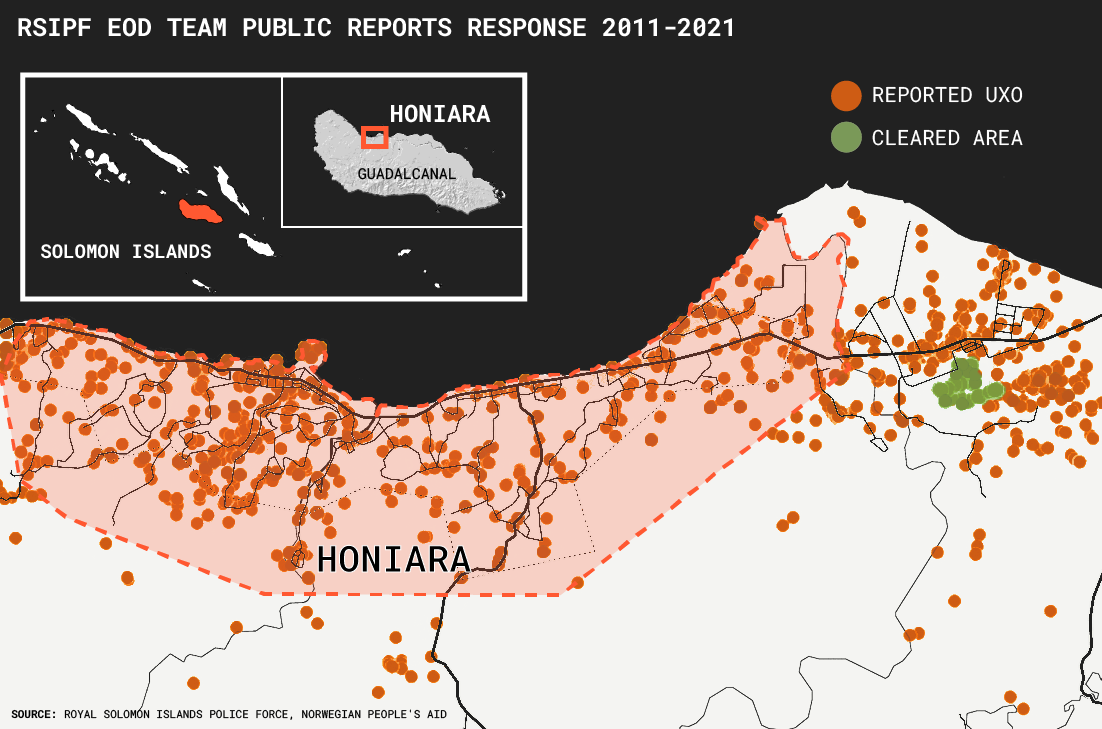19/11/2022 Isole Salomone, Guadalcanal, Honiara
“If you ever come across anything suspicious like this item, please do not pick it up, contact your local law e enforcement agency for assistance”.
International treaties have directed billions of dollars to countries ravaged by war. But World War II was a long time ago in the Solomons and help has passed it by. Aplatoon of decaying World War II tanks lines a barbed-wire compound surrounded by towering jungle, east of Honiara International Airport on the island of Guadalcanal. Shiny new Japanese-donated pick-up trucks and inflatable boats sit within its fences. This is the headquarters for the Royal Solomon Islands Police Force bomb squad. Inside, several of the squad’s 30 members work among scuba gear and maps, right next to an open air gallery of emptied bombshells and dirty Coca-Cola bottles, all dropped by servicemen 80 years ago. Nearby, live bombs are arranged in a secured storage unit, the dates they were unearthed recorded on masking tape with marking pens. They await disposal, many after decades of neglect. Since 2011, the police agency’s Explosive Ordnance Disposal team has destroyed more than 46,000 bombs. They’ve almost entirely come from the area surrounding the capital city of Honiara. Inspector Clifford Tunuki, the squad leader, sits in his office and considers the enormity of the task his team has been charged with. Bombs still litter the 300 acres of dense jungle surrounding the compound. It was once a WWII munitions depot, housing as much as 661 million pounds of ammunition of various calibers and sizes to fuel the U.S. war effort throughout the Pacific. But a grass fire in November 1943 tore through the compound, setting off a three-day blaze and countless explosions, hurling the depot’s contents — including live munitions — throughout the surrounding area. It has since been dubbed Hells Point. It is off limits to civilians. And it holds just a fraction of the dormant bombs littering the Solomon Islands. “There is much more there, in the field. Probably a million,” Tunuki says. “How long to get rid of them, to address it? It will take maybe 20 years or more.” The explosive remnants of World War II have plagued the Solomon Islands for 80 years. It’s been estimated that 30% of the bombs dropped by Japan and the U.S. during battle did not detonate on landing. And after the war ended in 1945, hundreds of thousands of tons of military paraphernalia – including munitions – were dumped and abandoned across the country, including in its waters. In the decades since the war ended, the Solomon Islands has made little progress in clearing its land of the bombs that continue to kill and injure its people on a regular basis. The U.S. and Japan have done little to clean up the mess they left behind and the Solomon Islands government has failed to seek the financial and technical help it needs. The threat of unexploded ordnance has frequently taken a back seat to other priorities and internal problems, including the developing nation’s unstable political situation.
Photo-Source: civilbeat.org
If you find anything that appears to be an explosive device, do not touch it, leave it where it is and call the police. We will contact the appropriate agencies to properly dispose of the item.
Dear editors, Biography of a bomb is aimed at highlighting the danger caused by unexploded bombs. Moreover, the most important aspect is that we work completely non profit, raising awerness about this topic is what drives us. We apologize if we make use of pictures in yours articles, but we need them to put a context in how findings are done. We will (and we always do) cite source and author of the picture. We thank you for your comprehension.





